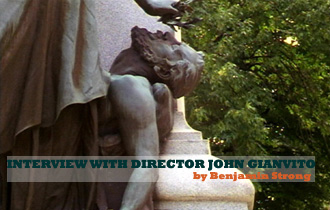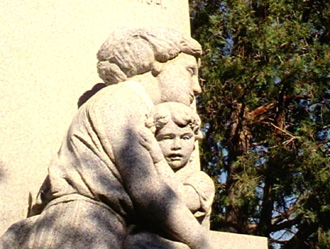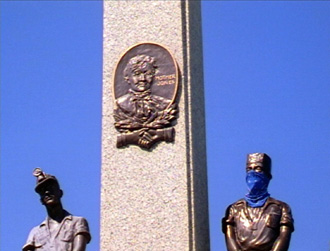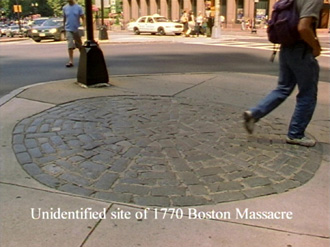Interview with Director John Gianvito
04.05.08
 It is difficult to describe John Gianvito’s documentary, Profit motive and the whispering wind, although the film is astonishingly simple. Inspired by Howard Zinn’s classic revisionist book, A People’s History of the United States, the movie is composed almost entirely of stationary long takes that show us monuments—gravesites, statues, and plaques—dedicated to Americans who, in one form or another, have advanced the cause of liberty. There is no voiceover narration, and very little text other than what you see written on the monuments themselves. In other words, for 58 minutes, you’re staring at a lot of inanimate objects. Sounds pretty boring, right? It is not.
It is difficult to describe John Gianvito’s documentary, Profit motive and the whispering wind, although the film is astonishingly simple. Inspired by Howard Zinn’s classic revisionist book, A People’s History of the United States, the movie is composed almost entirely of stationary long takes that show us monuments—gravesites, statues, and plaques—dedicated to Americans who, in one form or another, have advanced the cause of liberty. There is no voiceover narration, and very little text other than what you see written on the monuments themselves. In other words, for 58 minutes, you’re staring at a lot of inanimate objects. Sounds pretty boring, right? It is not.
Gianvito, a cinema scholar who has worked at the Harvard Film Archive and currently teaches at Emerson College in Boston, is a master of his medium. He understands that motion pictures are not strictly about moving images, but about how those images relate to sound and to time and to each other. Shot and edited over a three year period, Profit motive and the whispering wind is the work of a filmmaker who is unusually sensitive to his surroundings—to the way sunlight casts itself over the dimpled surfaces of aged stone, or to the percussive sound of raindrops beating onto leaves. The film induces a meditative state, hypnotizes by the specificity of the places to which the film seemingly transports you (not surprisingly, Gianvito has edited a collection of interviews with Andrei Tarkovsky, another director famous for holding his audience’s attention with a camera that’s largely still).
But watching Profit motive and the whispering wind, you may also find yourself by turns angry and sad. The Americans Gianvito’s film honors are not presidents and tycoons; they are labor leaders, abolitionists, suffragists, writers and other assorted radicals, many of whom died directly as a result of their efforts to make this country a better place. At a time when so many American political documentaries are loud, broad, abrasive, and didactic, Gianvito has made a movie about outrage that can best be described as quiet.
Gianvito recently spoke to Fanzine by email about his latest film and the American radical tradition. (For those readers who live in or near New York City, Profit motive and the whispering wind plays this weekend at the Tribeca Film Festival.)
FANZINE: Recently, you told a Cinema Scope interviewer that, living in Massachusetts you have, you have “always had a fondness for cemeteries.” Obviously, with our country’s colonial history there were bound to be a surfeit of New England monuments for you to shoot. And yet clearly you visit a number of sites that are not local to you. How much of the country did you actually traverse in making the movie? And what effect, if any, did this travel have on the project?
JOHN GIANVITO: I shot the film over three summers when I wasn’t teaching. During the school year I would undertake the bulk of the research and detective work to identify the sites I hoped to visit and to work out some kind of itinerary. There was only one far western swing where I flew into Los Angeles, rented a car, and a made a sojourn up the coast as far as Seattle, then over to Montana and Nebraska and concluding in Colorado. There were a couple of trips that carried me from Boston through the Midwest and down to Mississippi, South Carolina, West Virginia and elsewhere.
It’s certainly occurred to me how much more difficult this would have been if gas prices were what they are now. Towards the end of the shooting process I became interested in filming a site in Honolulu (of the grave of Robert W. Wilcox) but I just couldn’t swing the expense. Ultimately, I am well aware that there remain many other individuals and event markers that comprise this ”other history” that my film pays tribute to, but I hope there is sufficient breadth there and that the film speaks to the broader spirit of these energies.
As for what effect the travel itself had on the project, it’s hard to say. It did of course put me in a prolonged meditative space as I traveled alone for most of the shooting, wandered the cemeteries for hours and sometimes days alone, and had my own personal relation with each site as I stood before it. No doubt this contemplative state transmitted itself into the evolution of the film’s form.
 FANZINE: After my first viewing of the film, I had remembered the camera work—which is
FANZINE: After my first viewing of the film, I had remembered the camera work—which is
beautiful, and as you say, contemplative—as being handheld. But on a second viewing I discovered that the camera was most often still. I wonder if my misremembering has anything to do with the sense of vibrancy in each frame, the sense of movement—whether it is the sound of traffic in the background, or a caterpillar inching over a gravestone. In other words, there is nothing static about these very static images. How did you arrive at your technique?
JOHN GIANVITO: It’s interesting that you had that response, as indeed the only handheld shots in the film are usually when I wanted to film some smaller detail that I couldn’t get my tripod low enough to enable me to shoot.
I’ve always preferred compositions that allow my eyes to explore a frame without being tugged constantly every which way. I was also very cognizant of the fact that the very idea of making a film out of images of headstones might seem terribly “lifeless,” so to speak, and better suited for a photo essay than a film. I did seek to compose my frame so that the signs and headstones were placed within the context of their surroundings. If there was foliage I would sometimes stand in place on still days for long stretches of time waiting for at least some movement of air, or change in quality of light.
FANZINE: On a related note, I was very conscious of time while watching Profit motive and the whispering wind. What I mean is that—at least at first—I was worried that I wouldn’t have enough time to read all the text on a given monument before you moved to the next. I quickly realized that you had been careful to give your audience the necessary time in each case to read everything, and even to contemplate it for a moment before the succeeding cut. Was it difficult to determine how much time to allow for in each spot?
JOHN GIANVITO: While you are right in principle that I tried to take as much care with the precision in the editing that I was seeking in the shooting, you’ll be interested to know that almost all the photography in the film was done with a 16mm Bolex camera. This means that it was done with a key-wound spring (non-sync) and that I could not film an image continuously for any longer than 25 seconds (each roll of film being just shy of 3 minutes in length before I had to reload). In a very few places I am employing small exceptions—where I very carefully rewound the camera hoping not to alter the composition by a hair and continued filming, or used a small freeze frame in the editing.
I’m glad you had the experience you describe and certainly I tried to be as sensitive as I could in relation not only to the duration of any image but its relation to the image before or after and their relationship to the rhythms of the film as a whole. My hope is that one is able to spend some time not only with the immediate content of the words but with the content of the image itself—the texture of the stones, the aural environment around the sites, etc., as this as much a part of the essence of the film to me as the names and dates.
 FANZINE: Although many of the historical figures referenced in the film are unassailable—at least from the perspective of someone whose politics are to the left—you include a number of people whose stories may be more complicated. The first memorial shown in the film, for example, is for Anne Marbury Hutchinson, who is described in stone as an “exponent of civil liberty and religious toleration.” But the memorial also mentions that she was killed in a Native American raid, which could alter how we understand her story. Then there are controversial people like Sacco and Vanzetti, who are included in your history alongside confirmed heroines like Harriet Tubman or Sojourner Truth. Was it your intent to ask us to create a kind of revisionist history for these more ambiguous figures?
FANZINE: Although many of the historical figures referenced in the film are unassailable—at least from the perspective of someone whose politics are to the left—you include a number of people whose stories may be more complicated. The first memorial shown in the film, for example, is for Anne Marbury Hutchinson, who is described in stone as an “exponent of civil liberty and religious toleration.” But the memorial also mentions that she was killed in a Native American raid, which could alter how we understand her story. Then there are controversial people like Sacco and Vanzetti, who are included in your history alongside confirmed heroines like Harriet Tubman or Sojourner Truth. Was it your intent to ask us to create a kind of revisionist history for these more ambiguous figures?
JOHN GIANVITO: As the preponderance of the individuals and events are drawn from the pages of Howard Zinn’s book, they comprise a wide-ranging approach to the collective theme of individuals striving to better the world around them. Whether through organization building, direct action, through their writing, or public speaking, their art or public deeds, some via pacifist methods, some pushed to militancy, these are the stories of people with a passionate commitment to addressing injustices and inequalities of various kinds.
The intention is not to necessarily endorse all tactical approaches as obviously there are contradictions to be found. More crucially it is to encourage the simple recognition that these contributions and these stories have a vital place in the recounting of our history and in our ability to grapple with where we are now. The eradication of a proper understanding of this history only fosters further alienation, and confusion about how power really works in this country.
The story of Anne Hutchinson is just one example. Without further knowledge one is left to surmise her story and contribution from the few words on her monument. This was a dilemma I wrestled with at first. Should I provide text, or voiceover, summarizing the lives of these individuals? My worry was that it might turn the film into a sort of shorthand, Cliff Notes version of A People’s History. As well, I was concerned this would also give it more of a PBS-style caste, which I was clearly wanting to stay away from. While not being pedagogical, at least in the standard ways we think of the term, I felt the film might inspire one to ask oneself, why do I not know these names and events? And potentially to turn to books such as Howard Zinn’s landmark work as a starting place.
Anne Hutchinson was not in fact an enemy of native peoples and was simply at the wrong place at the wrong time. Indians on the shores of Long Island mistook her and her family for those who had recently defrauded them of their land. Hutchinson and her family, and the 35 families who joined her, would not even have left Massachusetts had she not been officially banished on charges of heresy and challenging government authority. What was her crime? She believed that “ordinary people could interpret the Bible for themselves” and she organized regularly and expanding study groups in her home, attended largely by women though not exclusively. For a woman to assert her knowledge and capacities as equal, if not superior, to men was deemed intolerable to the elite of the time. And the one person who spoke up in Hutchinson’s defense during her trial, Mary Dyer (the second monument you see in my film), was herself eventually hung on Boston Common for repeatedly defying a law banning Quakers from the Massachusetts Bay Colony. Not the typical colonial history that gets repeated in classrooms and stirs flag waving.
 FANZINE: The film ends with images of Americans protesting the Iraq War. The connection between these scenes and the rest of the film feels immediate and logical. And yet it’s a very sudden leap. What, for you, is the relationship between the “other history” you convey in Profit motive and the whispering wind and the historical moment we’re living through now. Has American radicalism died? Is it alive and well? Is it alive but ailing?
FANZINE: The film ends with images of Americans protesting the Iraq War. The connection between these scenes and the rest of the film feels immediate and logical. And yet it’s a very sudden leap. What, for you, is the relationship between the “other history” you convey in Profit motive and the whispering wind and the historical moment we’re living through now. Has American radicalism died? Is it alive and well? Is it alive but ailing?
JOHN GIANVITO: To clarify, not all the scenes in the finale pertain to the Iraq war. I shot various protest marches in DC, New York, and Boston and they include ones focused on immigrant rights, gay rights, and the Republican National Convention protests in which a host of issues were represented. But the war does dominate. For me, these images were intended to be predominantly emblematic. They were meant to speak in general, iconic ways of the ongoing existence of this trajectory of struggle—which I didn’t want people feeling is something just dead and buried. As well, it’s fair to say it represents an urge to inspire the viewer to step into that stream, and—in the face of meditating on the histories that the film documents, in its odd way—to potentially hear that history beckoning us to find our own way to contribute to this long struggle for the betterment of humanity (a struggle hardly confined to the U.S., which is the reason behind the use of “The Internationale”).
While it’s evident that there’s been a winnowing of large street protests in the past couple of years, I don’t see this as indicative of the collapse of a meaningful progressive movement. As others have pointed out, the growth of organizations like MoveOn.Org, CodePink, and others, are—from a historical perspective—indicative of a much more successful rallying of such energies. The sheer amount of money, the millions that have been raised by MoveOn is much greater than the funds raised by similar activist groups in the past, and are very targeted in their use. I believe people are searching for and here and there finding other, more efficacious ways to continue to fight the fight.
That said, again, trying to use history as a way of grounding myself, I think of Howard Zinn’s remarks about what it was like in the deep South in the early 1950s, and how seemingly remote the possibility appeared that there could be any rapid change to the problem of segregation. For many people at the time it appeared to be a distant hope. And yet, within just a few years, certain key events—Brown vs. Board of Education in 1954, Rosa Park’s refusal to move to the back of the bus the following year, sparking the famous Montgomery Bus Boycotts—a few incidents rapidly igniting a movement, started moving the country towards a resolution of these barbaric laws and practices. I think a lot of times there are things going on underground, smoldering desires that just need to find the right mechanism to unleash that energy forward.
I’m not pessimistic about the absence of people pouring out into the streets at this moment, although I certainly would like to see more evidence of real rage, targeted rage, against things such as this obscene war in Iraq and Afghanistan right now. I think people are in search of where they can best put their energies that will produce real change. I think that is part of what we’re seeing around the Barack Obama campaign. For me, there’s a lot of projecting onto him certain hopes and aspirations about shifting this country in a more sane direction.